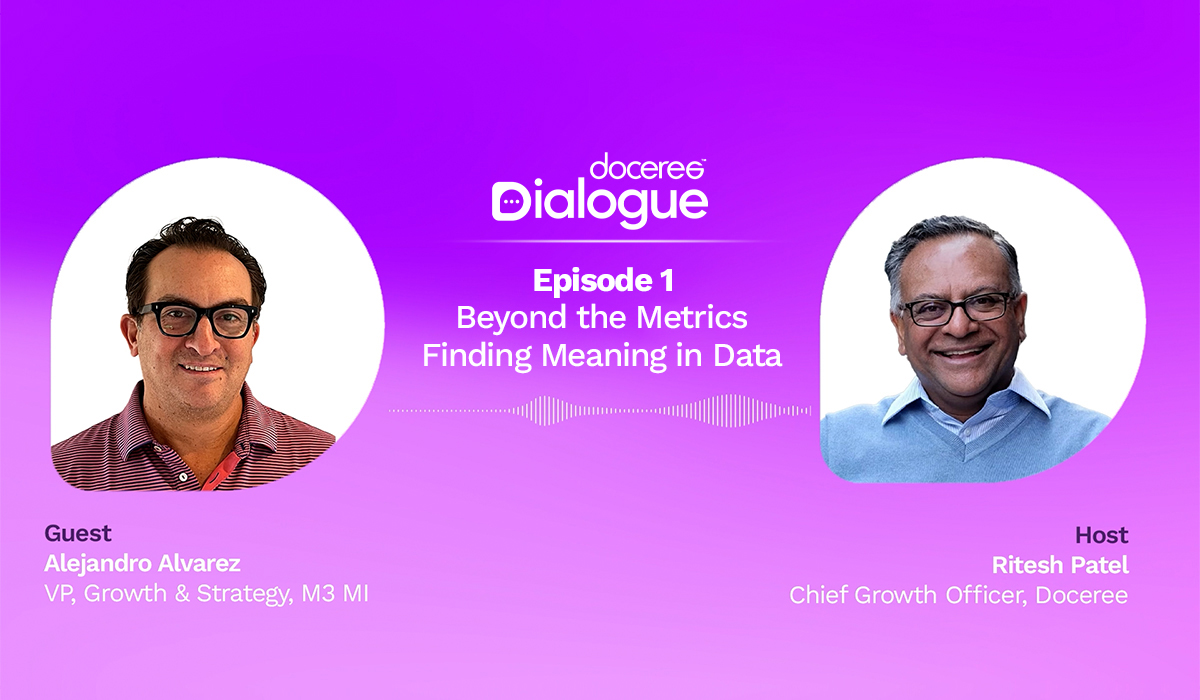
Doceree Dialogue: Alejandro Alvarez on Data, AI, and the Future of Meaningful Healthcare Engagement
The debut episode of Doceree Dialogue- Beyond the Metrics | Finding Meaning in Data, recorded live at Fierce Pharma Week, opened with a conversation that cut straight to the core of modern healthcare marketing: understanding how data and behavior intersect to shape communication between brands, physicians, and patients.
Joining the session was Alejandro Alvarez, Commercial Lead at M3MI, the syndicated research arm of the M3 Global Research division. In discussion with Ritesh Patel, Chief Growth Officer at Doceree, Alvarez offered a data-driven perspective on how healthcare professionals (HCPs) consume media, where they seek information, and how that behavior can inform smarter engagement strategies.
From Mailroom to Media Intelligence
Alvarez’s own story mirrors the evolution of healthcare media itself. He began his career decades ago as an intern at a company then known as Perk HCI, manually coding ads and mailing surveys to physicians. At the time, pharmaceutical marketing relied on just three primary channels — the sales representative, the sales aid, and the print ad.
“Back then, that was it,” Alvarez recalled. “Now, there’s an explosion of digital platforms and tactics reaching physicians everywhere.”
That explosion, he noted, has created both opportunity and complexity. With so much content available, the challenge isn’t access — it’s relevance. M3MI’s work focuses on decoding that complexity by analyzing behavioral data across physicians, caregivers, and patients to understand why they consume information where they do.
“Our data gives the ‘why,’” Alvarez said. “It helps explain why a doctor visits a specific site, or why a caregiver trusts one source over another. It’s about understanding motivation, not just measurement.”
The ‘Why’ Behind Every Click
The conversation explored one of the industry’s ongoing pursuits — data attribution. While attribution models reveal what actions occurred, Alvarez believes panel-based research complements them by illuminating the motivations behind those actions. “Attribution tells you what happened,” he said. “We tell you why it happened.”
Through syndicated research, M3MI provides a foundation for healthcare marketers to understand where to start their engagement efforts. For a new brand entering a specialty area like cardiology or oncology, the company’s datasets identify not only the right audiences but also the channels and contexts where those audiences are most active.
By layering behavioral data with claims and prescription data, M3MI helps marketers see which content platforms and journals correlate most strongly with clinical behavior — revealing not just reach, but real-world influence.
Understanding the New Physician Persona
The discussion also highlighted how HCP demographics influence digital behavior. Older physicians, Alvarez observed, may still prefer traditional journals, while younger doctors and certain specialties — such as oncology — are far more digitally native.
“A pediatrician might still rely on journals, while an oncologist is much more engaged online,” he explained. “Different specialties engage differently, and marketers need to recognize that nuance.”
That nuance, he suggested, is key to building omnichannel strategies that actually resonate — matching tone, content, and context to the preferences of each audience segment.
AI as an Amplifier, Not a Replacement
As the conversation turned toward AI, Alvarez acknowledged its growing role in the healthcare marketing ecosystem but framed it as a tool for augmentation rather than disruption.
“Imagine if AI could help us ask the right question and get the answer instantly,” he said. “It’s about making it easier to collect data and to draw insights from it.”
M3MI is already using AI to analyze how physicians engage with digital tools and to predict emerging patterns in media consumption — work that Alvarez believes will soon make healthcare insights faster, smarter, and more dynamic.
Toward a Unified Message for Patients and Physicians
Looking ahead, Alvarez’s prediction for the next 18 months underscored a key shift in healthcare communications: the need to unify messaging between physicians and patients.
“Brands often communicate to patients and doctors in completely different ways,” he said. “We need to bring those messages closer together — to make them resonate consistently across both sides of the care journey.”
That alignment, he added, will be essential as patients become more informed and physicians face increasing time pressures. Consistency and coherence in brand communication could well define the next chapter of healthcare engagement.
The Future Is in the ‘Dialogue’
The debut of Doceree Dialogue set the tone for what the podcast series intends to achieve — candid, insight-rich conversations with the industry’s most forward-thinking voices. In an era of abundant data but scarce attention, Alvarez’s message was clear: the future of healthcare marketing will depend less on producing more content and more on understanding human behavior deeply enough to make every message matter.